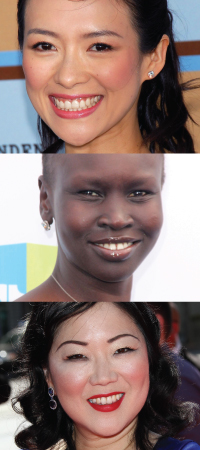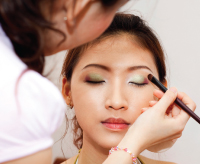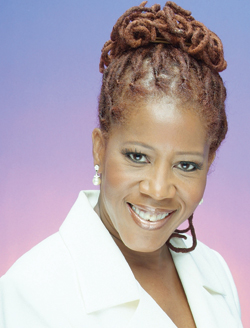I began my aesthetic career as a makeup artist. Inspired by the training I received from one of the finest skin care schools in the United States, I felt very confident on my first day at work apprenticing as a makeup assistant for a national hair magazine. What I quickly discovered was that everything I had been taught was the antithesis of what real life makeup application was about.
Many aesthetic schools do not provide their students with an education that prepares them to work on a variety of ethnic skin types. Unfortunately, the same holds true for makeup training which, more often than not, is skewed to a European standard of beauty. For example, many instructional diagrams on how to create the perfect eyebrow still advise students to measure from the outside edge of the nose.1 However, applying that technique to a client with a wide nose would result in the eyebrow beginning at the center of the eye.
Since people of color represent at least 70 percent of the world’s population, it is important for a makeup artist to have a broad perspective on beauty in order to hit the ground running in a diverse, global market. The most important thing I have learned, after eight years as a professional makeup artist with over 6,000 makeup applications, is that everyone’s face is unique. There are rules but they do not always apply to every client. These days, it is a rare occurrence to apply makeup straight from the bottle for a perfect skin match.
 Bone Structure
Bone Structure
According to the Egyptians, classic beauty was defined by a complex formula which asserted that the closer a face or object is to the golden ratio (phi) of 1.618, the more beautiful it becomes. In simpler terms, if the length of the face is divided into thirds and each segment is equal and the widest part of the face matches that measurement as well, it is proportionately close to perfection.
Many of us do not have the time to assess a client’s face prior to applying makeup. Our goal is to simply apply the makeup in a way that will define and accentuate their physical beauty to show them in the best light possible.
In order to do this, the makeup professional must truly see their client and sometimes it means using more than their eyes. Since they will find different variations within all ethnic groups, it is virtually impossible to formulaically apply makeup by race. Some women have tremendous bone structure and, even if the professional is a beginner, it would be almost impossible for them to make a mistake when applying makeup to their client’s face. Chinese actress Ziyi Zhang and Somalian model/entrepreneur Iman and come to mind as they are well-known for their obvious facial bone structure. However, if the professional applied makeup to Sudanese supermodel Alec Wek or Korean-American comedian Margaret Cho, both of whom have round faces with a more obscured structure, they might not find it so easy to apply makeup to their client’s faces.
The initial step for defining bone structure with makeup is to first determine where the bones are located. This means knowing where the hairline begins, where the eye sockets and cheek bones are, recognizing the beginning of the jaw line and the shape of the chin. During the course of a makeup application, the professional should gently feel with their fingertips to see the client’s bone structure. Depending upon how fleshy the client’s face is, and how inexperienced the professional is, it may take a moment. Makeup clients would rather know that the professional is being precise in their application rather than guessing and possibly risking a poor result. After this method has been used for a while, the professional will find that they will no longer have to feel your way. Furthermore, once the bones are found, the makeup application should begin to fall into place because the key to a stellar application is to create symmetry and balance.
It is important to never just jump right into starting a makeup application. When it is time to begin the application process, the end result for the client should be the focus. For instance, which features does the client want to emphasize and minimize? Do they want a natural or more dramatic look? Once the desired look has been determined, the makeup professional should stand behind their client and assist them when looking in the mirror, turning their head at different angles. This will provide the professional and the client with various perspectives of how the light plays on their face.
Foundation
Often, too much makeup is applied to women of color. Makeup is designed to even out skin tone. If you learn how to properly match the makeup to the skin, it is unnecessary to overapply, producing an unattractive mask-like effect. Professionals need to acknowledge and comprehend that dark makeup hues make facial features recede – lighter colors highlight and enhance. Moreover, pearlized makeup should not be used as a base during a makeup application on dark skin tones as it may appear purple tinged or gray.
Foundation color must match the skin exactly – this is non-negotiable. It is the basis for everything applied afterward. If the foundation color is inaccurate, the finishing powder, eye shadow, lipstick or blush will not look appropriate either. But if the foundation is correct, all other enhancements can be modified in a number of ways (think day to evening) and the face will still look fabulous.
Many ethnic women will have up to three different shades of natural color on their face, but there are at least two tones which need to be paid close attention to. The first is the primary color of the client’s face. The second is the undertone. This is the part that gets a lot of makeup artists into trouble because, for various reasons, they cannot discern this nuance with clients that have darker skin types. I believe that they simply have not trained their eyes to recognize the distinction.
The easiest way to determine undertone is to turn your client’s wrist over so that the underside of their arm is exposed. Are you seeing more yellow, pink or reddish-blue tones? If you are unsure, pick out a red-, pink- and yellow-based concealer, apply to that area and see which one blends best. This will give you a clue as to the undertone of the foundation you should be applying to their face, which will be darker. It is rare to find a single color to be an exact match. In my personal experience, I do not recall a makeup application that I did not have to mix at least two colors for perfection. I would also recommend foregoing color correctors when it comes to darker skin tones. I think the green and purple tones are confusing and often do not give great results. For women of color, you will need foundation colors in cream or liquid that range from ivory to ebony with at least two intermediate shades, all with undertones of yellow or red (two of each shade).
 Application
Application
The first step in applying makeup is to prepare the skin so that it is pristine, without flakiness; then apply a favorite primer. Foundation is where a majority of the makeup application’s time will be spent, due to the need for perfection.
Begin the application by selecting a foundation two shades lighter than the client’s primary skin tone. This will be the highlighting shade and it does not have to be mixed. Stick foundations are quick, easy and fun and they can be applied to imperfections, hyperpigmentation or other areas that may want to be highlighted. For most women, this will be on the forehead, under the eyes, top of the cheekbones, corners of the mouth, and on the chin. Run a stripe of highlighter down the center of the nose as well. The foundation should be thoroughly blended using a triangle sponge precision; however, the use of fingers will help the makeup heat up on the skin for a smoother application.
If the face needs to be narrowed, a strip of color should be applied on the top of the client’s cheekbones and down the center of their nose – ascertaining that the application is sufficiently blended into the skin. Next, a dime size amount of the perfectly mixed shade (which matches the client’s skin) needs to be applied to the balance of their face, blended well into the lighter areas to prevent lines of demarcation. The result should be an evenly toned face with a slightly more pronounced bone structure.
During the application process, it is important to diligently inspect the client’s face for breakthrough areas of imperfection or severe hyperpigmentation. If the foundation is not enough to provide camouflage, this is where a cream concealer comes into play (a color up to one-half a shade lighter than the client’s foundation can be used). By using a tiny brush to apply coverage to these areas, the color can be pressed into the skin to ensure coverage. Concealer kits with different variations of the same are highly beneficial because they allow for customization.
Once satisfied with the coverage, a two-ply tissue should be used to separate it. Lastly, using a fat powder brush, the finishing powder should be applied (making sure excess powder has been tapped off) and lightly brush onto the face and jaw. This process is accomplished by gently pressing the tissue into each area of the face to set the foundation and absorb excess oils.
 Dark sculpting can be done before or after foundation. During the first step if you want to define the cheekbones and nose more, a shade of foundation can be used that is two shades darker. Place this in the hollow under the cheekbone or on the sides of the nose and other areas that need minimizing. However, this trick is best left to more experienced makeup artists. It is easier to apply a darker powder after foundation, blend well and use a finishing powder which will help soften and diffuse sculpting.
Dark sculpting can be done before or after foundation. During the first step if you want to define the cheekbones and nose more, a shade of foundation can be used that is two shades darker. Place this in the hollow under the cheekbone or on the sides of the nose and other areas that need minimizing. However, this trick is best left to more experienced makeup artists. It is easier to apply a darker powder after foundation, blend well and use a finishing powder which will help soften and diffuse sculpting.
Color
Because color choices are dictated by personal preference, style, circumstances and trends, it is impossible to say what will or will not look good on a woman. A variation of most colors can be worn by all women. Often, it is simply a matter of what the eye is accustomed to. A prime example is red lipstick which most women have to grow into before feeling comfortable wearing it. Here are some suggested guidelines for using color.
 First, when contemplating eye shadows, to be trendy with a strong eye shadow color, or to coordinate with a particular clothing item, the client’s entire eyelid does not need to be covered. A soft, smoky eye can be achieved by using a shade of gray and applying the strong shade onto the center of the eyelid for just a pop of color; blend well. Also, do not eschew pastels. Pink, purple and green shadows often look wonderful on amber skin tones. Additionally, some shades of metallic eyeshadow look good on everyone. Gold looks good on red or blue undertones, silver on yellow, and bronze works on everyone. Finally, keep in mind that the darker the skin, the more pigmented the eye shadow and lip color should be.
First, when contemplating eye shadows, to be trendy with a strong eye shadow color, or to coordinate with a particular clothing item, the client’s entire eyelid does not need to be covered. A soft, smoky eye can be achieved by using a shade of gray and applying the strong shade onto the center of the eyelid for just a pop of color; blend well. Also, do not eschew pastels. Pink, purple and green shadows often look wonderful on amber skin tones. Additionally, some shades of metallic eyeshadow look good on everyone. Gold looks good on red or blue undertones, silver on yellow, and bronze works on everyone. Finally, keep in mind that the darker the skin, the more pigmented the eye shadow and lip color should be.
Next, do not cause a face war by using a strong eye color and lip color. Pick one feature and go neutral on the other. There are four elements to creating a perfect full lip – lipliners, color, gloss and highlighting the center bottom. To even out an uneven lip tone, use foundation. Follow with a lipliner and creamy lipstick, however, staying clear of pearlized lipstick is highly advised.
In conclusion, remember that when applying blush tones they should be in the range of a natural flushed skin color. Also consider that some shades of bronze will work on all skin tones. Furthermore, it is imperative that when testing for color, the professional does not test on their own skin. It must be done using the client’s skin.
Resources
1 Women’s Health. “Eyebrow Shaping 101: Pluck the Perfect Eyebrows.” <www.womenshealthmag.com/beauty/pluck-eyebrows>
 Linda Harding-Bond is the president of Moontide Consulting. She specializes in training spa therapists to maximize performance through retail sales and client engagement from a multicultural perspective. She is an award-winning aesthetician, featured writer for Huffington Post, creator of the blog, Ethnic Skin Aficionado and author of The New Esthy Handbook: An Essential Guide for Novice or Nervous Estheticians. She may be contacted at This email address is being protected from spambots. You need JavaScript enabled to view it..
Linda Harding-Bond is the president of Moontide Consulting. She specializes in training spa therapists to maximize performance through retail sales and client engagement from a multicultural perspective. She is an award-winning aesthetician, featured writer for Huffington Post, creator of the blog, Ethnic Skin Aficionado and author of The New Esthy Handbook: An Essential Guide for Novice or Nervous Estheticians. She may be contacted at This email address is being protected from spambots. You need JavaScript enabled to view it..
Want to read more?
Subscribe to one of our monthly plans to continue reading this article.